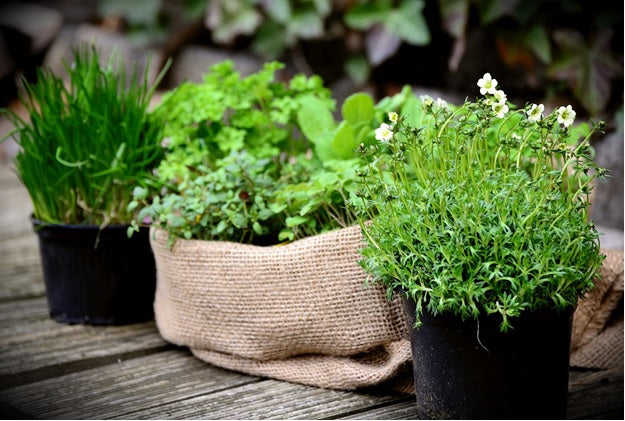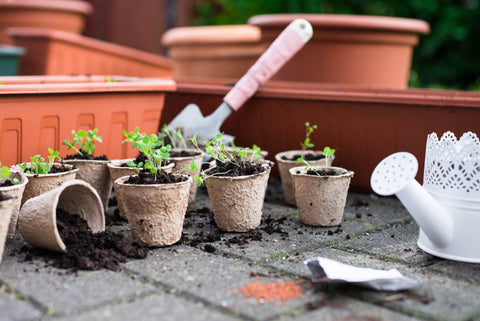
Cooking With Fresh Herbs
Are you looking to add more flavor and color to your food. Fresh herbs can do that, and a lot more. They can make the simplest dish appetizing by adding a pleasing aroma and a pop of fresh color. Also, there’s a host of health benefits of fresh herbs you wouldn’t want to miss out on. From thyme, basil and oregano to lavender and mint, there are all sorts of different flavors and textures to explore. Next time you go to the farmer’s market, spend some time to look at the herbs section and see what you can find.
Fresh VS Dried
Choosing fresh vs. dried herbs to add to your dishes is a matter of preference. Undoubtedly, the most nutrients are packed in the fresh form of herbs. However, in the dried form, flavor becomes concentrated in smaller quantities. So you’ll have to cut down the amount in half to get the same flavors out of dried herbs.

Grow Your Own
Herbs will only last in the refrigerator for a couple of days. For the freshest herbs, it’s best to grow your own. Herbs are the simplest plants to grow and a good choice for beginners, even when you don’t have much gardening know-how to start with.
If you don’t have an outdoor garden, choose a sunny window to place your plant pots. The best thing about herbs is that they don’t take a lot of space. If you choose a rectangular window planter, you can grow different kinds of herbs together in the same pot.
If you don’t want to wait too long before starting to harvest them, grow them with seedlings. With good potting soil and the right amount of moisture, you’ll soon be able to start snipping the leaves to add them to your dishes.
How To Cook With The Most Popular Fresh Herbs
To make the best out of herbs, you should know exactly how to use them. Unfortunately, adding them to the dish isn’t enough. You should know just when to add them and just how much heat they can take before the flavor starts depleting. Here’s how to use some of the most common herbs in the kitchen:

1. Basil
This is a tender annual herb that comes in many different varieties, each with its own unique colors, taste and uses. Opal basil has attractive maroon foliage and works perfectly in salads. Thai basil has a hint of anise flavors, while the classic Genovese basil is the key ingredient for pesto. It’s an important ingredient in Mediterranean dishes, in which it’s often paired with tomatoes. It’s also popular in Asian cuisine, to add some balance to the spicy dishes.
Basil is best used while still fresh, and works well in a variety of dishes, including meat and fish. You can also use it in salad platters or as a garnish on pizza as soon as it comes out of the oven. For best flavors, add basil near the end of cooking. Tear, or roughly chop the leaves to add to soups or other dishes and discard the stems. The most flavors are packed in the leaves.

2. Cilantro
Cilantro or coriander leaves are brightly colored and refreshing, with a hint of lemony flavor to kick up your recipes. It’s a popular ingredient in many cuisines, including Mexican and Vietnamese. The stems are as flavorful as the leaves and are used as a fresh herb. Dried seeds are used both whole and ground as a spice.
It works perfectly in salsas and stir-fries. It also pairs well with chicken and fish. The fresh color and grassy flavor compliments just about every dish, from soups and curries to salads. However, since heat tempers the fresh flavor, add it right before serving.

3. Parsley
Parsley is one of the most versatile herbs to have in the kitchen. Its mild flavor adds the perfect balance to soups, stews and sauces. You can also add them fresh to summer salads. Though leaves hold more flavor, stems are also chopped and used alongside. Parsley works well with many ingredients, including lemon, eggs, butter and pasta.
Flat leaf parsley holds more flavor than the curly variety, which is why many cooks go for the former. Flat leaf parsley works well for cooking, while curly parsley makes a fresh garnish. Since the flavor is mild, you can use a lot of the herb without any risks of overwhelming the dish.
4. Dill
A relative of parsley, dill has a distinct flavor that works well in a variety of dishes, from salads, egg and vegetables to fish and meat dishes. You can also add it to sauces and dressings. It’s the key ingredient for dill pickles, popular throughout the US.
Dry dill has little flavor, so cooks often go for fresh dill. Add it near the end of the cooking process since heat takes away much of the flavors. Use it only sparingly, because fresh dill often has a strong flavor. You can also combine it with other herbs, including mint or parsley, or use it on its own for a standalone flavor.
5. Oregano
Also called wild marjoram because of its stronger flavor and aroma, oregano is the perfect seasoning for pizza sauces, spaghetti and tomato-based dishes. Dried oregano is an excellent substitute for fresh ones since it’s also very flavorful.
Oregano holds well against the heat, so you can add it at an early stage of cooking to build up flavor. Since it has a strong flavor, only add it sparingly if using it as a garnish to prevent overwhelming a dish. Both stems and leaves can be roughly chopped to add to the dish and are both flavorful, though stems can be a bit woody.

Conclusion
Fresh herbs add a pop of color, aroma and unique flavors to your dishes. If you’re not growing your own, store them in a damp paper towel inside a plastic bag to enjoy the freshness for the longest. Even so, use them within the next few days before they start losing flavor.
